6 Mistakes Business Owners Make with Their StoryBrand Brandscript
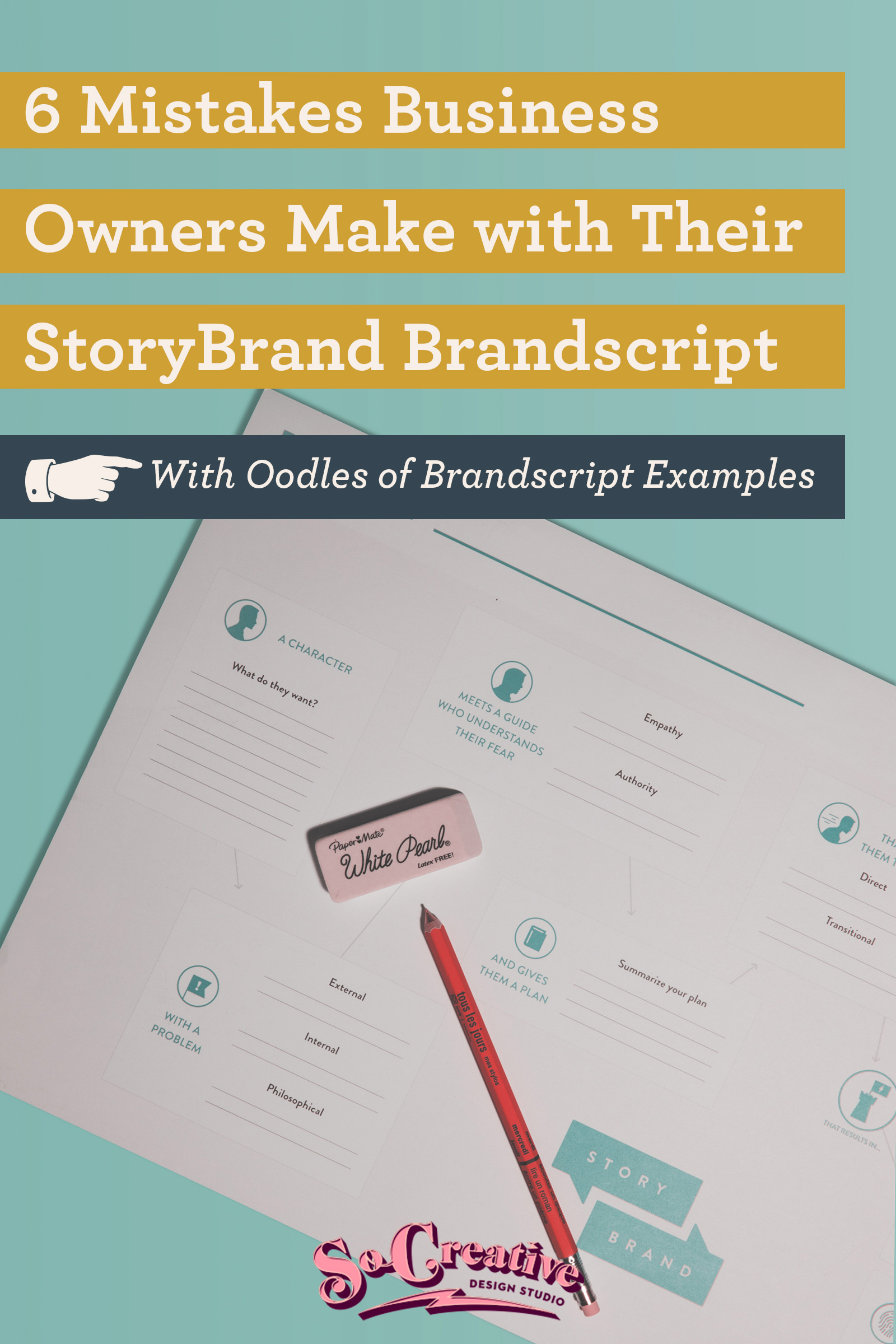
So you’ve read Building a StoryBrand. Maybe you’ve even taken the online course. Now it’s time to create your StoryBrand Brandscript and get your brand’s messaging out into the world so you can connect with customers on a deeper, meaningful level.
Well not so fast! Before you get started, we’re going to fill you in on six StoryBrand Brandscript mistakes we’ve seen time and time again.
Not familiar with StoryBrand? No worries- we’ve got a whole resource section to help you understand one of the brand strategy tools with use with all our clients.
When you’re feeling confident that you’re ready to roll out a StoryBrand Brandscript on your own, sign up for the free StoryBrand Brandscript online tool and use these tips to help you along the way.
Mistake #1: Too Many Problems with the Problem
Okay, so we lied- kinda. There’s actually more than six StoryBrand Brandscript mistakes we see, but a big chunk of them revolve around the problem, so we’re tackling those all at once.
When we work with our clients on their StoryBrand Bransdscripts, we always spend the most time on the problem section.
Because if the problem isn’t figured out correctly, the rest of the BrandScript is going to fall apart.
One Problem With The Problem: Too Many Problems and No Focus
AStoryBrand Brandscript should have one, overarching problem. If that one problem isn’t narrowed down, and we start flinging all kinds of problems customers could be facing into the messaging, we’ll get only noise.
If you can’t narrow down your customers’ overarching problem, you need to dig deeper into the customer research phase of brand strategy. That’s why every time we develop a StoryBrand Brandscript for a client, we spend even more time on customer research beforehand. This makes identifying the problem a breeze.
Another Problem With The Problem: The External, Internal, and Philosophical Problems Don’t Flow
One problem needs to lead to the next, and that needs to lead to the next.
Let’s say, for example, you have a vintage guitar shop and are writing your StoryBrand Brandscript.
You’ve determined that your customer’s external problem is not being able to find the vintage find they’re looking for.
Internally that’s going to make them feel frustrated. Maybe even impatient- they want that guitar now!
But if your philosophical problem is, “You deserve a one-of-a-kind guitar like no other band in the business,” that doesn’t flow with the stated problem.
If the problem was wanting to have a stand-out guitar that gets people talking, then yeah. It would work.
Instead, a more appropriate philosophical problem would be, “You shouldn’t have to spend years hunting down the vintage guitar you’ve been looking for.”
The Final Problem With the Problem: The External Problem is an Internal Problem
This happens more often than not. I’ll ask a client what their customer’s external problem is and they’ll say something like, “Overwhelm.”
That’s an internal problem. It’s something you feel.
What is causing this overwhelm? Is it not knowing what clothing to shop for? The amount of paint choices in the paint aisle?
Get in there and make sure your external problem is truly an external force that is making your customers feel a certain way.
Want to check out more on how to nail the problem section of your StoryBrand Brandscript? Check out this article.
StoryBrand BrandScript Example: Art by Donna Marie
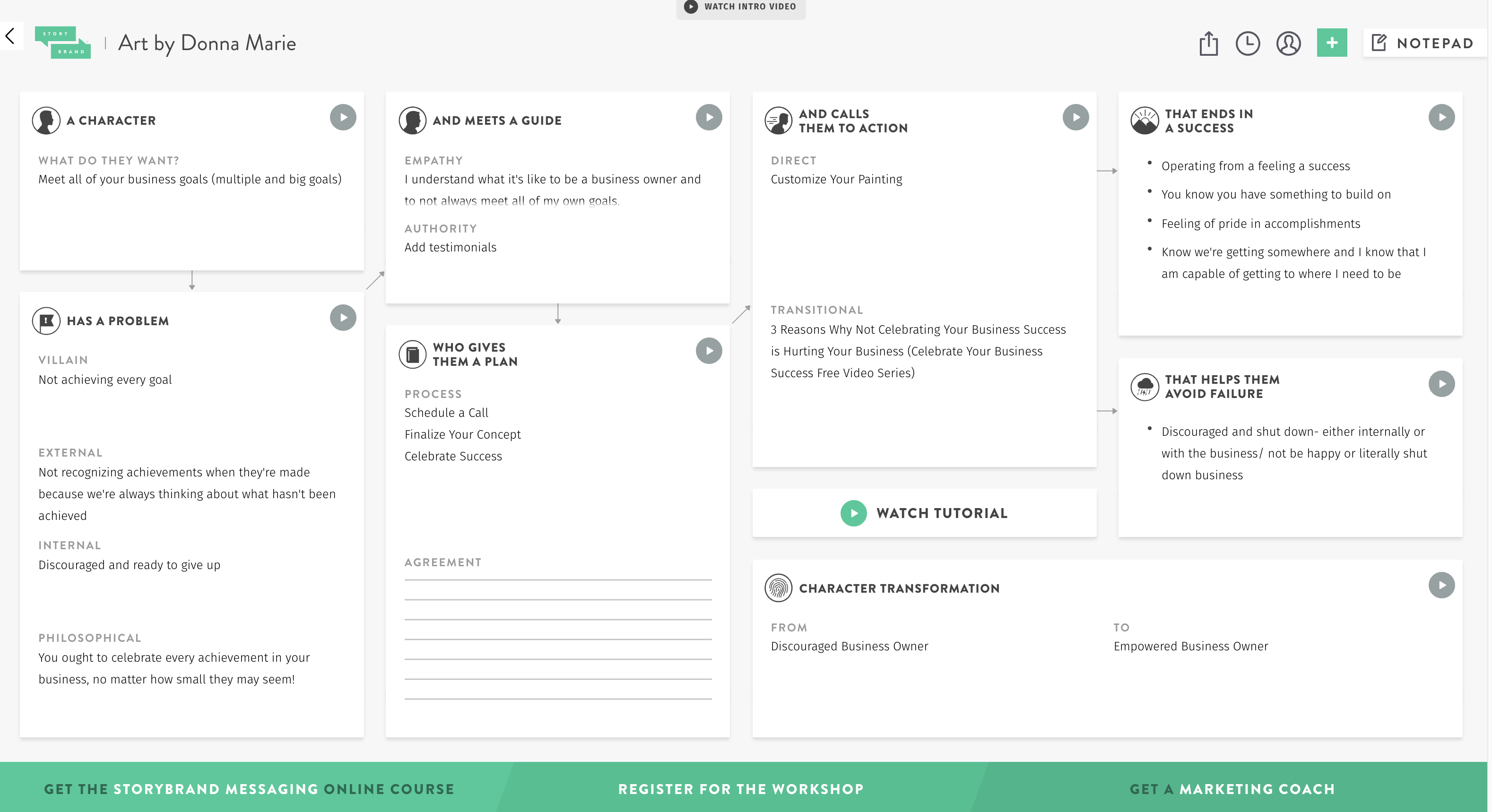
Determining a problem for fine art can be tricky. That’s why it was important while working with fine artist, Donna Marie, to really get into the minds of her customers.
And her custom paintings are for business owners who want to celebrate their business’ success. The paintings serve as a symbol of how far their businesses have come.
But even though this may not seem like a service that solves a problem, it does.
Donna Marie’s clients don’t always stop to recognize their achievements in business (external problem) and that makes them feel discouraged and ready to give up (internal problem). Donna Marie believes that you ought to celebrate every achievement in your business, no matter how small they may seem (philosophical problem). And her paintings- they’ll help you do just that!
Mistake #2: Not Ending the Process Plan With Success
If you’re choosing a process plan over an agreement plan, you probably have a service that you want to walk people through so they can see how easy working with you is.
But don’t forget the last step- which is success.
Often times we’ll see clients that come to us with StoryBrand Brandscripts that look something like this:
- Schedule a call
- Choose Your Service
- We’ll get to work
But you getting to work isn’t the end of the process.
Success is the cowbell of your messaging- you can never get enough.
Take every opportunity you can to paint a picture of what life will be like after working with you. Make your final step in the process plan the moment your clients have been waiting for!
Still not sure how to craft your plan? Check out this article.
StoryBrand BrandScript Example: Ecomulch
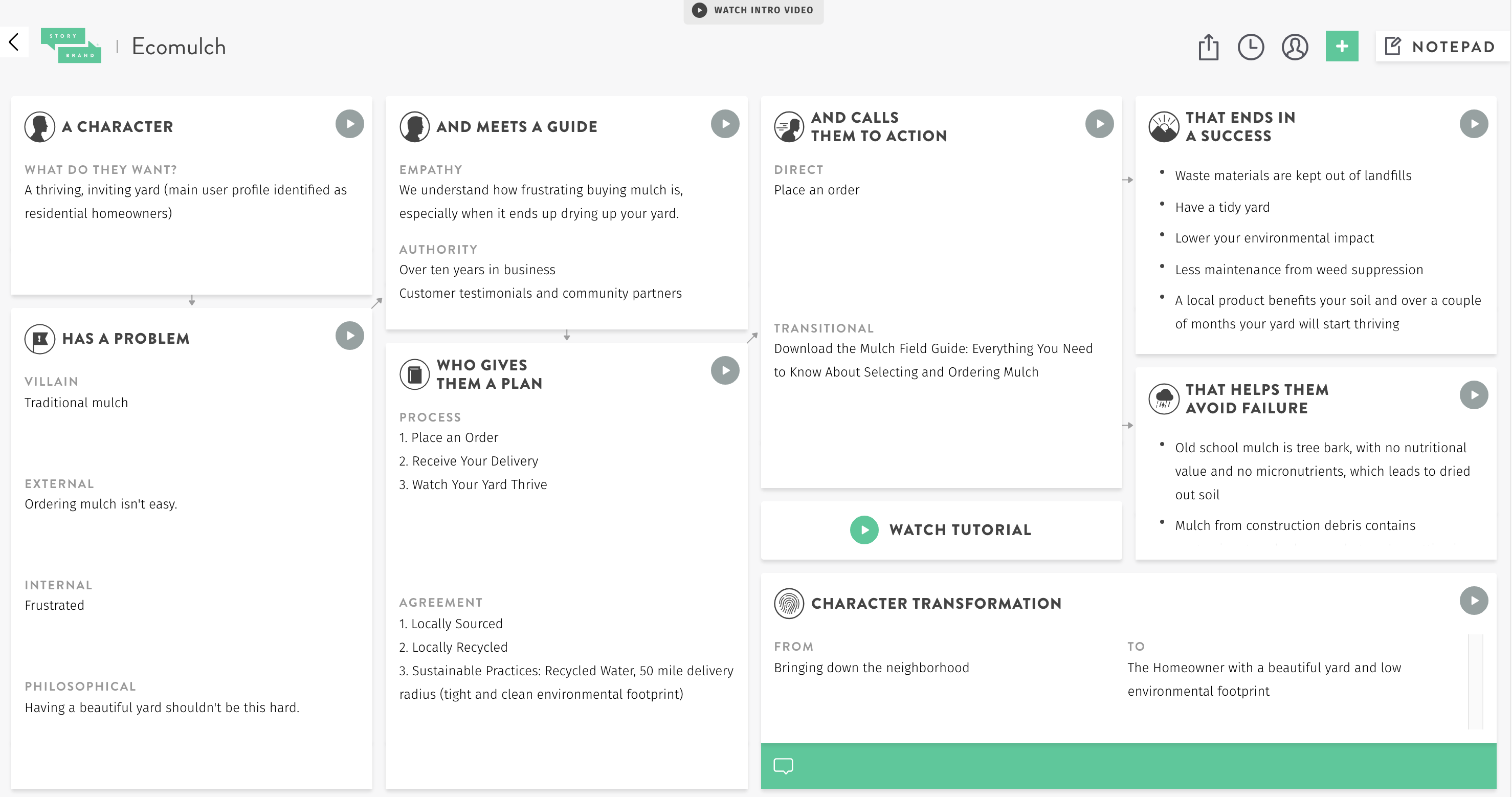
While working with Ecomluch, we knew what the big win at the end of buying their organic mulch would be.
A yard that’s thriving- plants, plants, plants everywhere! A yard the neighbors will slow their roll for and be like, “Ooooooo, I want some of what they’ve got going on!”
So we made sure that the last step in their process plan wasn’t, “We’ll deliver your mulch.” Boring! There’s nothing emotional in that. And people buy for emotional reasons.
All you need to do is place your order, Ecomulch will deliver the goods, and you just need to sit back and watch your yard thrive.
Mistake #3: Generic Empathy
Now StoryBrand is absolutely correct in speaking to empathy in marketing. It’s not just a good idea- it’s essential.
You need to really understand where your customers are coming from.
But this is where we’re going to say the emphasis on empathy needs to go much deeper.
Yes, it’s great to get the “We understand…” phrase into your StoryBrand Brandscript, but if that’s all your doing to truly show empathy for your customers, it’s not enough.
It’s flat. It’s forced. It’s something you felt you had to do because StoryBrand said to put it in your messaging.
Empathy needs to be at the root of everything you do.
It’s how you know to pivot your business because there’s a global pandemic and your community needs you to show up in a different way.
It’s how you know to maybe hit the breaks on selling for a bit because your customers are enraged by police brutality and need a different type of messaging.
So yes, get your “I understand…” statement into your StoryBrand Brandscript, but remember to make it a much bigger part of your overall brand strategy.
Not sure how? You can start by doing a deep dive into what your customers really need with this article.
StoryBrand BrandScript Example: Marlene Oliphant Interiors
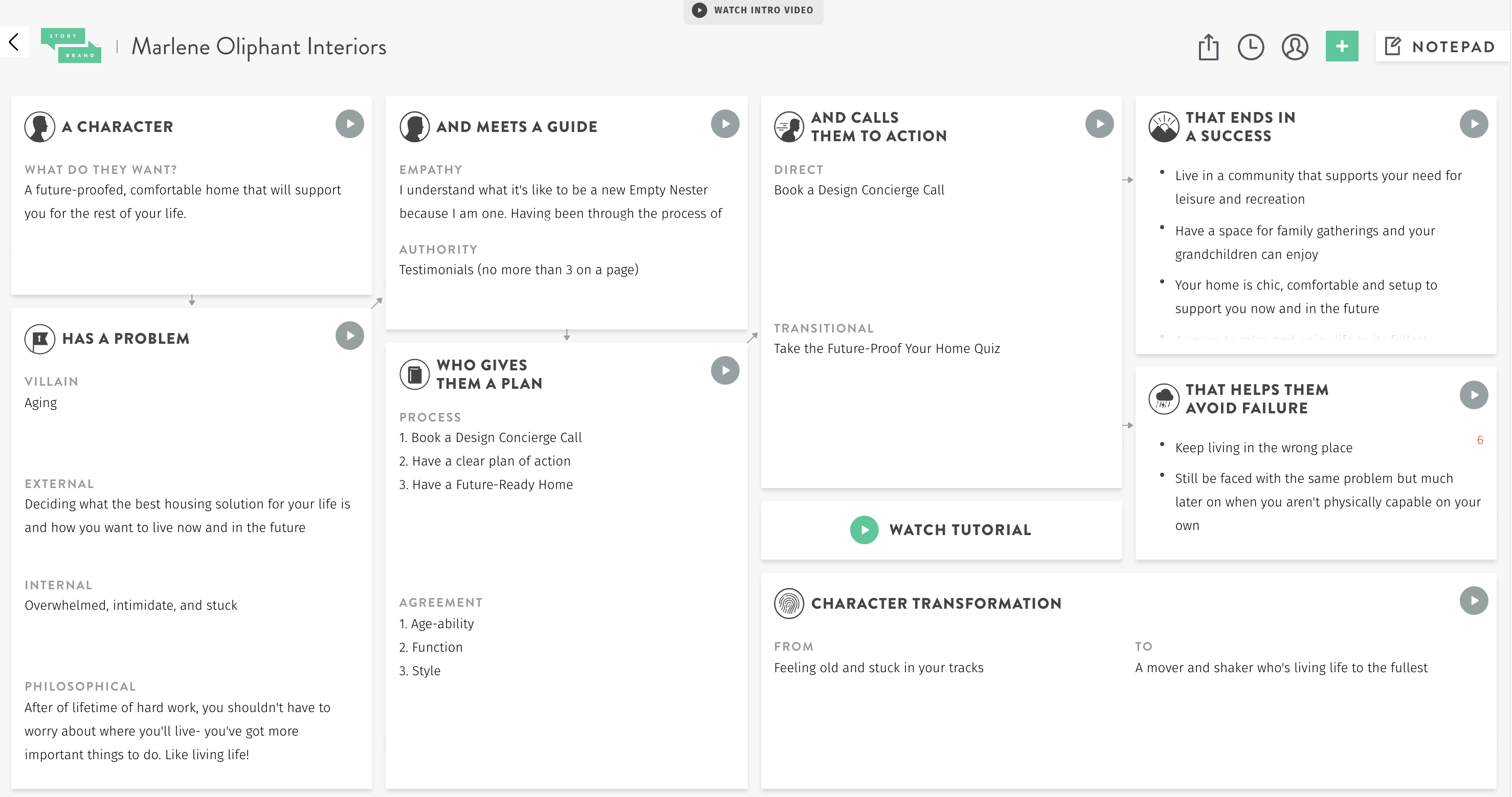
Our client, Marlene, really understands her clients.
Because she’s just like them. And not in the forced, “I feel your pain,” kind of way.
Before she decided to focus her interior design studio solely on Baby Boomers, she went through the process of setting up her home for the rest of her life. She has so many stories to share with her community about all the little decisions that need to be made.
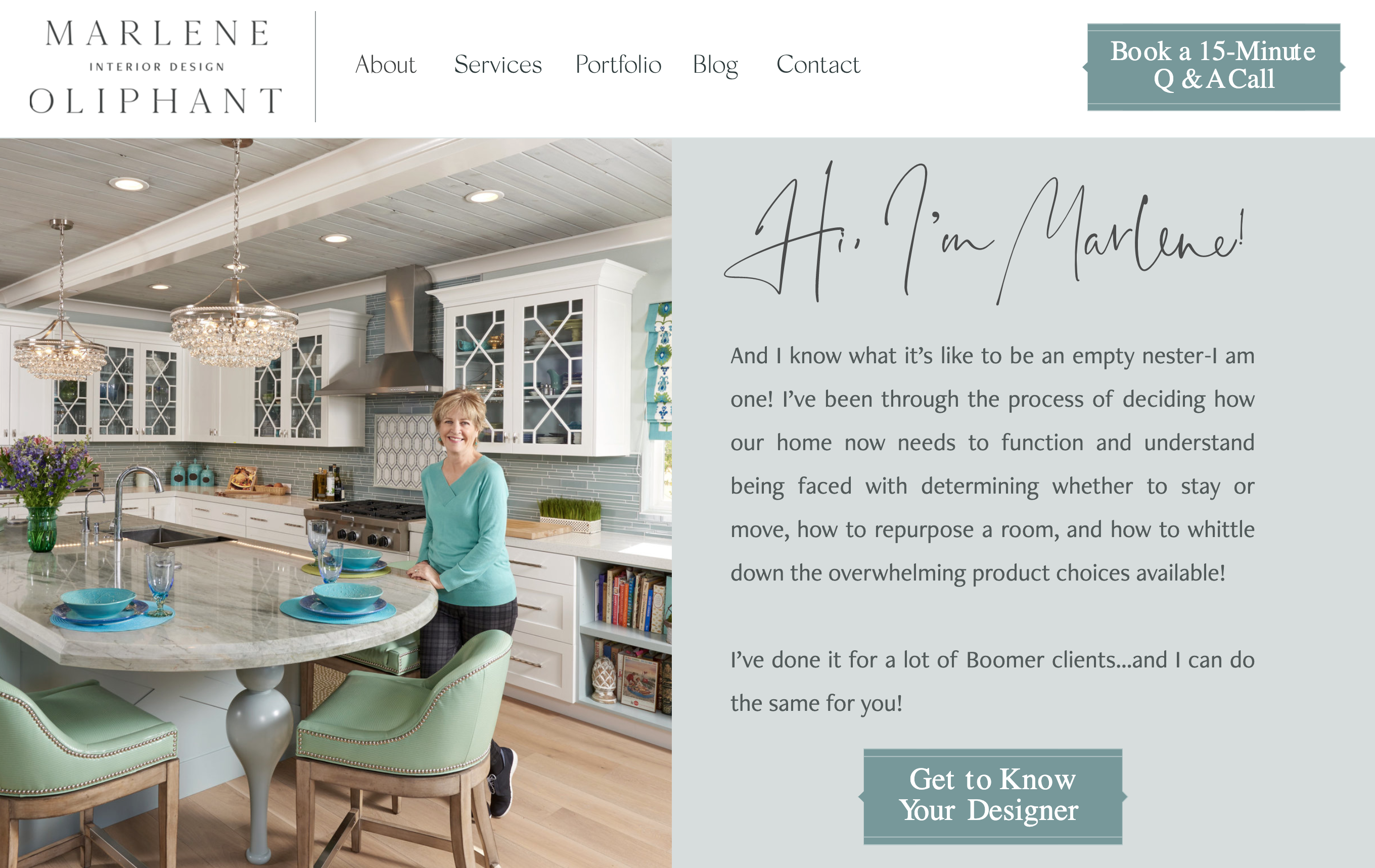
Empathy is in everything Marlene creates. And while we did include the “I understand…” statement in her StoryBrand Brandscript, we also made sure her homepage featured a section about her, and we told her story on her about page so clients finally feel understood and know they’re hiring a designer that isn’t going to make mistakes that could not only cost money, but cause physical harm.
Mistake #4: Weak Calls to Action
Many times clients will come to us not knowing what their call to action is- because they haven’t thought about what they really want people to do.
If you’re a service provider, this is a systems issue, and we help you work that out during brand strategy. Are you setting up a phone call, scheduling consultations, having potential clients apply?
If you’re in the hospitality space, you probably want people to book a reservation.
If you’re eCommerce, what are you wanting to sell? The latest collection? A subscription?
And then there’s the transitional call to action.
The biggest problem here is not seeing the value in building an email list, so business owners leave it out.
You want to give your customers a little taste of what you have to offer with a PDF, quiz, discount code- there are literally hundreds of content ideas you can offer your website visitors as enticing little bits to give up their email. So if they’re not ready to buy right now, they might be in the future. But they’ll forget all about you if they’re not getting email updates.
StoryBrand BrandScript Example: Dixie Willard Design
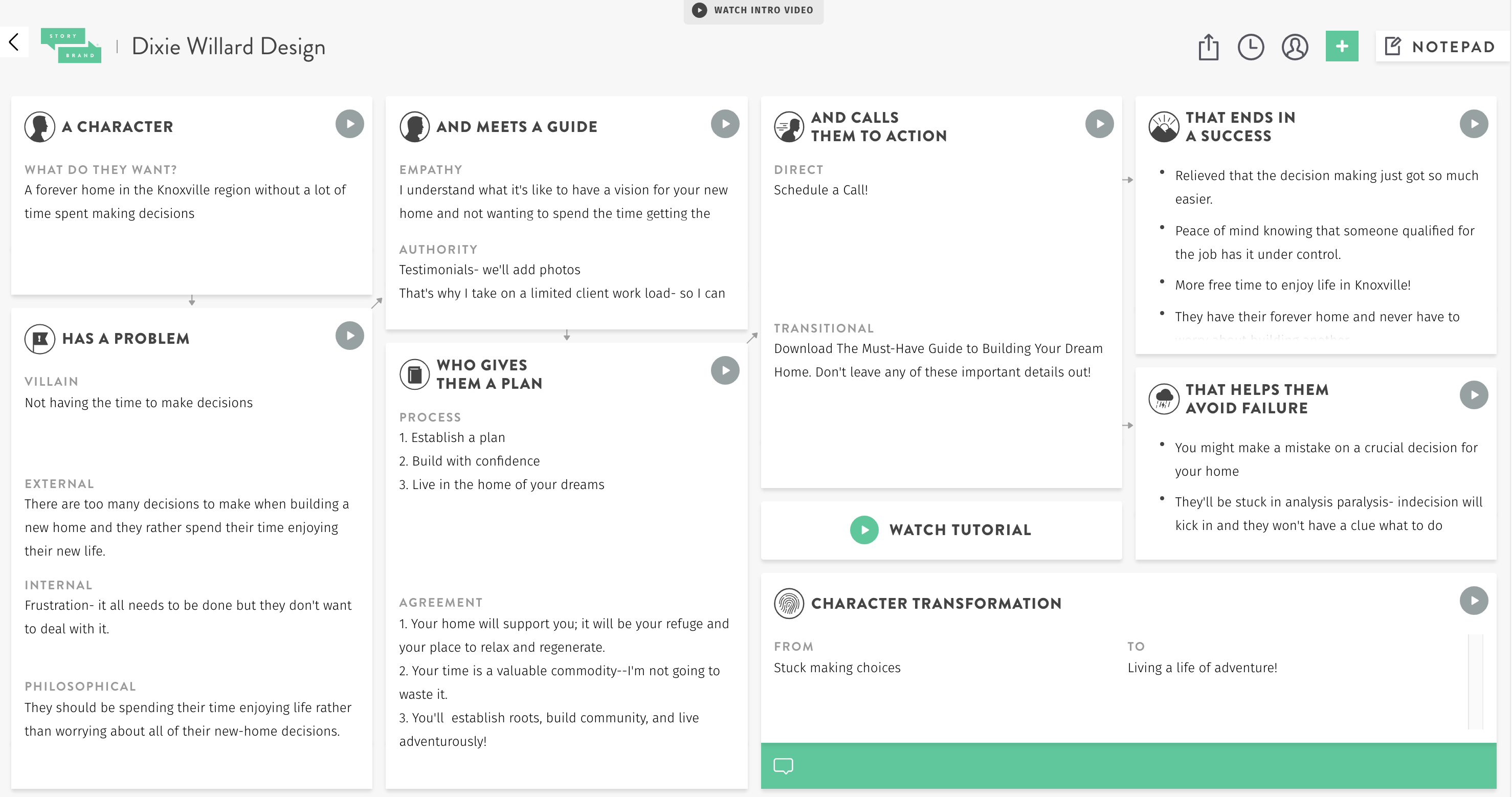
Our client, Dixie Willard, has a very particular type of client in mind. She wants to work on ground-up construction. And she wants to make sure that not only she is the right fit for her clients but also that they are the right fit for her services.
Her direct call to action is to schedule a call. She wants to get to know them a bit first.
Dixie also doesn’t want to focus on interior styling- it’s just not what she loves about interior design. So she offers “The Must-Have Guide to Building Your Dream Home” to website visitors. This not only prequalifies anyone on her email list as someone who’s interested in building a new home, but it also allows for her to keep in touch with potential clients through email.
Mistake #5: Not Nailing the Aspirational Identity
Who do your customers want to become? What is the hero-version of themselves that your business will help them achieve?
This is actually the first thing you need to nail in your StoryBrand BrandScript- the transformation.
Make sure this is solid before moving on and filter all your messaging through this transformation.
Who are your customers now? Who will they become?
If you’re in the luxury, lifestyle, or hospitality industries, the aspirational identity is the most important part of your messaging. You might not even use other parts.
You don’t hear Tiffany’s talking about internal struggles.
And Gucci doesn’t need to highlight a three-step plan.
Neither do lower-end clothing brands- it has nothing to do with the price point. If you sell a lifestyle product, your messaging needs to revolve around an aspirational lifestyle.
StoryBrand BrandScript Example: Tiny Bubbles
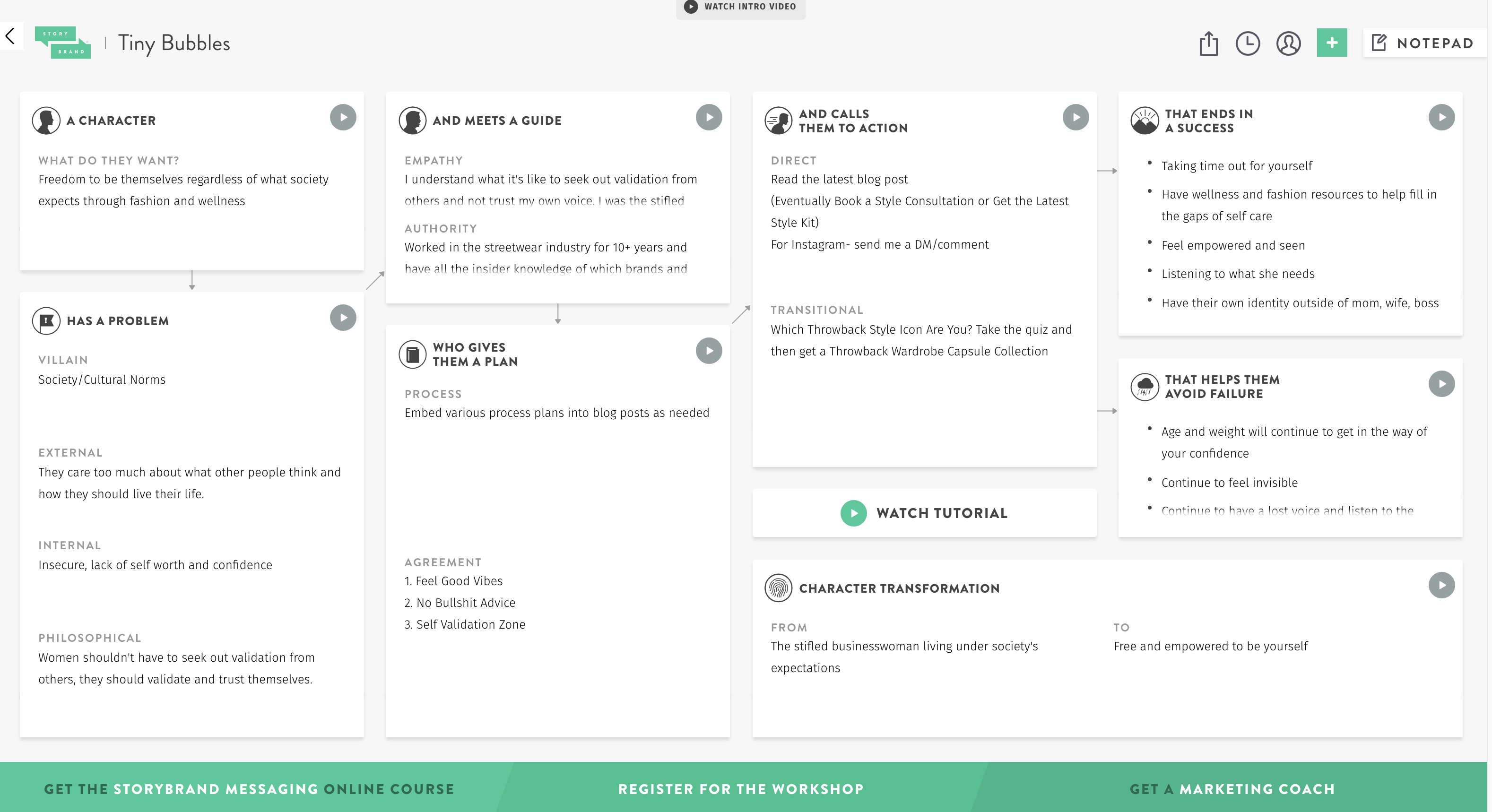
We’re currently working with Tiny Bubbles to create a lifestyle brand in the female empowerment space through the lens of clothing and wellness.
And while we’ve filled up all the buckets in her StoryBrand Brandscript, we know that her content and brand identity design need to revolve around the lifestyle Tiny Bubbles is encouraging women to live. Her content plan goes far beyond a messaging guide. Her StoryBrand Brandscript is just the starting point.
Mistake #6: Only relying on a StoryBrand Brandscript in Your Business Strategy
If you’ve made it this far, you may have noticed our thoughts on just using a StoryBrand Brandscript to determine your brand strategy.
It’s not everything you need.
And if you’re only using a StoryBrand Brandscript to message and market your business, you’re using a template. A one-size fits all strategy for business, when no business is like another (at least it shouldn’t be).
You need to determine your customer’s core needs.
You need to determine how you’re going to differentiate your brand from competitors.
You need to create a plan to build brand awareness. Nobody’s going to just find your messaging!
Your brand only gets one first impression- and it will be a visual one. You need a brand identity that connects with customers on an emotional level.
So yes, create your StoryBrand Brandscript, but know it’s just one piece of a much bigger brand-building puzzle. You need full brand strategy and a visual brand identity that creates an immersive brand experience that connects your business with the perfect customers.


